
In the world of outdoor gear, two famous brands that we’ve often come across are Norrøna and RAB, one is Norwegian and the other British.
Each with its own rich history, important accomplishments, and commitment to quality, these companies have earned the trust of outdoor enthusiasts around the world.
Today, we’ll take a closer look at their origins, materials, and offerings to determine which brand might better suit your outdoor needs.
Let’s begin!
Contents:
1. Norrøna Outdoor Gear
History of the Brand
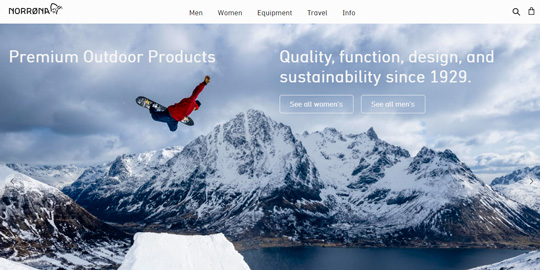
Norrøna official website
In 1929, a Norwegian outdoor enthusiast named Jørgen Jørgensen, known for his love of nature embarked on a quest to find durable equipment suitable for Norway‘s challenging climate. This initiative marked the inception of Norrøna, as Jørgensen began crafting basic items such as leather products, canvas backpacks, and cotton clothing.
The company saw a change in leadership in 1948 when Bjarne Jørgensen, the second generation Jørgensen, assumed control. Over the years, Norrøna broadened its product range and shifted its focus to technical and mountain gear.
In 1971, Ole Jørgen Jørgensen, third generation, took over as manager, and engineer Tomas Carlstrøm was brought on board to assist in the development of backpacks and mountain tents. During the 1970s and 80s, Norrøna gained acclaim for its pioneering products and sponsorship of expeditions.
Notable milestones during this period included the introduction of the first tunnel tent in 1972, the debut of Europe’s first Gore-Tex jacket in 1977, and the provision of equipment for the first winter ascent of Trollveggen in 1979.
Design became Norrøna’s third building block in 2000, with a focus on “Loaded Minimalism” and an emphasis on sleek, practical design. The company embarked on international expansion in the mid-2000s, opening new collections and stores in North America and Europe.
Sustainability became Norrøna’s fourth cornerstone in 2015, with a commitment to transparency and a pledge to donate 1% of sales to environmental programs.
Today, four generations later, Norrøna remains a family-owned company headquartered in Norway. Under the stewardship of current manager Jørgen Jørgensen, the company continues to innovate technical outdoor gear steeped in Norwegian heritage.
Don’t miss:
9 Brands like Norrøna: Our Best Alternatives
Norrøna vs Jack Wolfskin: Which is Better?
Materials, Fabrics, and Production Process
Norrøna prioritizes the use of high-performance, eco-friendly materials in its product line. They are recognized for their utilization of sustainable fabrics such as organic cotton, recycled polyester and nylon, as well as down insulation that adheres to the Responsible Down Standard (RDS) guidelines.
Norrøna actively participates in sustainability initiatives, including the Fashion for Good organization, and operates a 1% for Nature program, donating a portion of their annual sales to environmental causes.
The company is committed to complete transparency in its sourcing and manufacturing processes, with sustainability forming a fundamental aspect of its business ethos. They strive to create technical products while minimizing environmental impact and promoting the use of eco-friendly materials.
This dedication is evident in their leadership in sustainable outdoor apparel and gear.
In line with other leading outdoor brands, Norrøna incorporates innovative fabric technologies and materials, such as various versions of Gore-Tex membranes, Polartec performance fabrics, and PrimaLoft synthetic insulation.
The natural down used for insulation is sourced from the Pyrenees in France, with bird treatment complying with European high standards.
The video will be loaded from YouTube.com, a third party. If you play it, you accept their terms of service, and their use of cookies.
Read also:
Norrøna vs Patagonia (Outdoor Gear Comparison)
Norrøna vs Arc’teryx Women’s Ski Jackets: Which Brand To Choose?
Where is Norrøna outdoor gear made?
Norrøna’s outdoor equipment is manufactured in various facilities situated across Europe and Asia. Presently, the brand utilizes manufacturing plants in Lithuania, Spain, Portugal, Denmark, and Sweden in Europe, and Vietnam, China, and Thailand in Asia. (source)
Recommended Products
Norrøna trollveggen down 850 Men’s Jacket
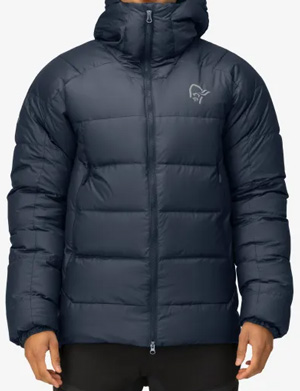
Image: norrona.com
Check it out at Norrona.com
The Trollveggen down 850 Men’s Jacket is a high-quality mountaineering down jacket constructed with aeroDownproof face fabric and packed with RDS-certified 850+ fill power down to provide exceptional insulation without adding extra weight.
It includes windproof Pertex Quantum 30D 100% recycled polyester face fabric, 100g PrimaLoft Gold insulation in the pockets and on the shoulders, convenient hand warming pockets, an insulated hood, and an extended back length for protection.
Read also: 10 Norwegian Jackets and Clothing Brands that You’ll Love
Norrøna lyngen 40L Pack
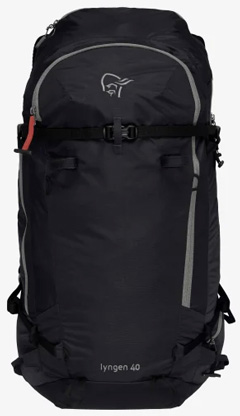
Image: norrona.com
Check it out at Norrona.com
The Norrøna Lyngen 40L Pack is a robust and lightweight backpack specifically crafted for ski touring, mountaineering, and trekking. Constructed from resilient ECONYL® material, the pack boasts water-resistant properties, high-quality YKK zippers, and a well-ventilated back.
It’s equipped with dedicated compartments for avalanche gear, crampons, and a rope, and is optimized for carrying ski and snowboard equipment. Notable features are the compression straps, a hip belt with a pocket, ice ax attachments, and a chest strap.
Also, the adjustable shoulder straps are designed with a 3D construction to enhance breathability.
Read also: 3 Best Norwegian Backpack Brands: Our Top Picks
Prices
Norrøna produces resilient and warm jackets and outdoor equipment crafted from premium materials that can endure demanding activities. However, the initial investment is higher compared to numerous other brands, with their jackets ranging from $300 to upwards of $1000, and their backpacks priced between $100 and $700.
Are Norrøna products worth the price?
In our opinion, Norrøna’s outerwear and equipment represent excellent value for money for enthusiasts of advanced and expert outdoor pursuits. The brand employs cutting-edge technology to produce jackets that provide warmth and comfort. They also offer a range of vibrant, distinctive designs not easily found in other brands.
However, for casual outdoor pursuits or beginners in a specific sport, exploring more budget-friendly brands might be a better idea.
Learn more: Why is Norrøna so Expensive? Are Their Jackets Worth It?
2. RAB Outdoor Gear
History of the Brand
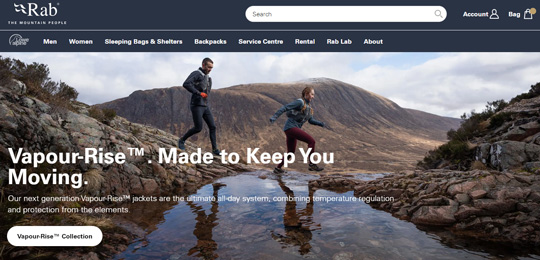
RAB official website
RAB‘s origins can be traced back to 1981, when Rab Carrington, a Scottish climber, established the brand in Sheffield, South Yorkshire, England, under his own name.
Renowned for his passion for nature, climbing, and adventure, Rab Carrington gained recognition as a prominent mountaineer among his peers. In 1973, while in Buenos Aires during a UK strike and lacking equipment, he began crafting his own gear with guidance from a friend, Hector Vieytes, who taught him the art of creating high-quality sleeping bags.
These skills inspired Rab Carrington to launch Rab, positioning the company as a creator of products “by climbers for climbers.” Over the years, Rab has introduced numerous products that have become very popular in the mountaineering and climbing communities.
In 2001, the brand partnered with Polartec, whose materials continue to be utilized in Rab’s gear today.
Since 2003, Rab has been under the ownership of Equip Outdoor Technologies Ltd, which has upheld the brand’s ethos and has designed renowned jackets like the Microlight Alpine, solidifying its reputation as one of Europe’s fastest-growing providers of technical outdoor clothing.
Don’t miss:
7 Brands like RAB for Outdoor Adventures
8 British Outdoor Clothing Brands that You’ll Love
Materials, Fabrics, and Production Process
Every year, Rab demonstrates a strong commitment to environmentally friendly production practices by ethically sourcing materials and utilizing PFC-free water-repellent treatments.
The brand also emphasizes the use of recycled materials and the creation of durable products. Polyester and nylon are the primary materials of the company.
Waterproof outerwear is crucial for winter, and Rab employs various fabric technologies, including Gore-Tex, Pertex Shield, Proflex, and Pertex Shield+, to ensure dryness in all weather conditions. These fabrics come in three different constructions: 2, 2.5, and 3 layers, tailored to specific uses.
For breathability, Rab utilizes Hydrophilic and Microporous technologies, both designed for moisture-wicking.
The brand offers a range of natural down and synthetic insulated jackets and sleeping bags, with responsibly sourced natural down and a line of jackets made from recycled fabrics and down insulation.
While natural down is an excellent insulator, Rab also utilizes synthetic insulation, primarily Stratus, Cirrus, Pyrotec, and PrimaLoft, for jackets, sleeping bags, and gloves.
The video will be loaded from YouTube.com, a third party. If you play it, you accept their terms of service, and their use of cookies.
Read also:
RAB vs North Face (Outdoor Gear Comparison)
RAB vs Patagonia Outdoor Equipment: A Comparison
Where is RAB outdoor gear made?
Rab’s products are made partly in the UK, where the company is headquartered, and the rest in Asia, predominantly in China.
Recommended Products
RAB Men’s Microlight Alpine Down Jacket
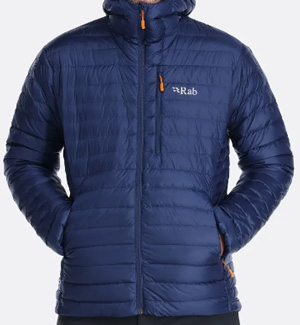
Image: rab.equipment
Check it out at rab.equipment
The Microlight Alpine represents a lightweight winter jacket that features 700 fill-power hydrophobic down for insulation, offering warmth and water resistance in wet conditions. Its Pertex Quantum shell technology ensures durability against the elements and provides breathability, catering to various activities.
The jacket includes two hand pockets and a chest pocket, with the former being harness-compatible. Available in men’s and women’s sizes, the Microlight Alpine is highly compressible, for easy transport.
RAB Aeon 35L Daypack
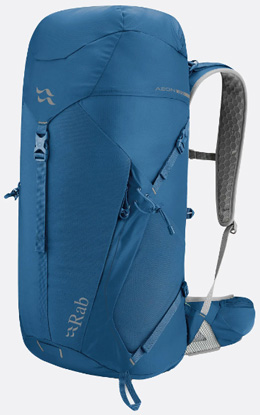
Image: rab.equipment
Check it out at rab.equipment
The RAB Aeon 35L Daypack is a versatile backpack designed for a range of mountain activities. It features the Air Contour X carry system, offering a secure fit and the ability to handle substantial loads while ensuring stability on challenging terrain.
The semi-rigid back panel promotes air circulation and conforms to the user’s body. The adjustable back length allows for a customized fit. With a 35-liter capacity, the pack is well-suited for camping and hiking and includes practical features such as TipGripper walking pole attachments, a walking axe loop, and easily accessible stretch pockets for gear storage.
The zippered hip belt pockets provide storage for small objects, and the backpack is crafted from 50% recycled nylon fabric. It’s also equipped with a rain cover for all-weather protection.
Prices
Rab is not an affordable brand, but it’s also not among the most expensive we’ve seen. The brand’s jackets start at around $80 (for windbreakers and lighter styles) and can reach up to $850 (for down jackets and technical designs). The backpacks range from about $60 to $250 based on the design, and the other equipment and accessories vary.
Are RAB products worth the price?
While the answer depends on your product expectations and needs, RAB has a reputation for crafting durable, premium designs. So, we think it’s definitely worth it!
Learn more: Why is RAB so Expensive? Is It Worth It?
3. Which is Better? Norrøna or RAB?
Now this is the most important part of the comparison. Which brand to choose? Here are our considerations:
Quality: Both brands are famous for high-quality, durable outdoor gear. Materials and construction are very good across their product lines. Some notable materials that both use are Gore-Tex and Pertex fabrics, and PrimaLoft and Polartec synthetic insulation. Also, both offer natural-down-insulated gear, with the down being responsibly sourced.
Design: Norrøna tends to focus more on Scandinavian aesthetics with clean, minimalist designs. RAB gear has a more technical look and focus.
Features: RAB gear often incorporates the latest technical fabrics and features. Norrøna aims for functionality but with a more classic aesthetic approach.
Prices: Norrøna gear tends to be slightly more expensive on average compared to RAB. Both brands offer good value for the price you pay though.
Sustainability: Both brands are committed to sustainability and use eco-friendly fabrics as much as possible.
Outdoor activities: RAB gear has a more technical, mountaineering, and alpinism focus. Norrøna products cover a wider range of outdoor activities from hiking to mountaineering to skiing.
In the end, both offer high-quality gear that will stand up to rigorous use. Norrøna offers a slightly more minimalist Scandinavian aesthetic. For most outdoor activities, you can’t go wrong with either. We’d personally choose Norrøna for skiing and snowboarding, and RAB for climbing and mountaineering.
Read next:
10 European Down and Puffer Jacket Brands for Winter
13 Scandinavian Jacket and Clothing Brands that You’ll Love
